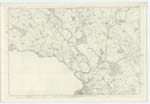OS1/10/11/70
| List of names as written | Various modes of spelling | Authorities for spelling | Situation | Description remarks |
|---|---|---|---|---|
| Site of DUMFRIES CASTLE | Site of Dumfries Castle Site of Dumfries Castle |
John McCormack Peter Mundell |
049 | [situation] On the N.W. [North West] side of Church Crescent. The Site of an Ancient Castle which Stood on the ground on which the New Church is built. Neither record nor tradition exists to tell when it was built, but history records it as a place of importance during the 12th Century And during the times of Succession wars. - It appears to have undergone some alterations and repairs from time to time. It also appears by Some records that King Edward of England made some additions and alterations to it. From a rough Sketch taken by an Old man now in Dumfries from an original drawing it appears to have been a large building - Attached to it was a Chapel, and it was surrounded by a Strong wall which enclosed a Considerable Extent of ground. It enclosed the Area upon which Church Crescent, Irving Street and part of George Street and Castle Street now stand. An intelligent man about 70 years of age named John McCormack remembers to have seen part of the above walls standing before Castle Street was formed and can from recollection and tradition point out nearly the whole extent of the site of the above wall. In Chalmers Caledonia Vol.3. Page 135 is the following Notice "There was a Castle here which was called the Old Castle even before the Age of William the Lion. This Castle was allowed to fall into ruins and a new Castle was built nearly on the Same Site. - Standing thus near a Conterminous border, the Castle of Dumfries became an object of frequent contest during the Succession Wars. - During the Contest for the Crown, this Castle was put into the interested hands of Edward I. When this Arbitrator awarded the Crown to John Baliol, he ordered this Castle to be put into the possession of this defendant Monarch. - When Edward I dethroned Baliol, he tooK possession of Dumfries Castle as devolved to him as Sovereign Lord. - He repaired and strengthened this Castle in which he placed a Garrison which he amply supplied with provisions. - When Robert Bruce slew John Comyn in Greyfriars Church on the 10th of February 1305-6, he immediately seized the Castle and drove away the English Justiciaries, who were then sitting in Dumfries. The Castle was afterwards taken by the English who held it in 1309 - 1311. Bruce retook it July 1312. |
Continued entries/extra info
[page] 70 -- Parish of DumfriesTranscribers who have contributed to this page.
Chr1smac -Moderator, VickiColeman
Location information for this page.
Linked mapsheets.




